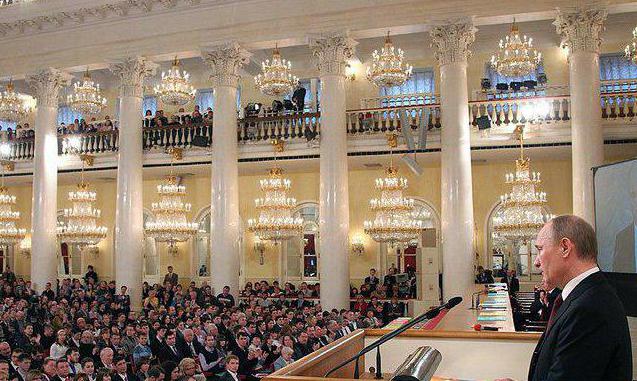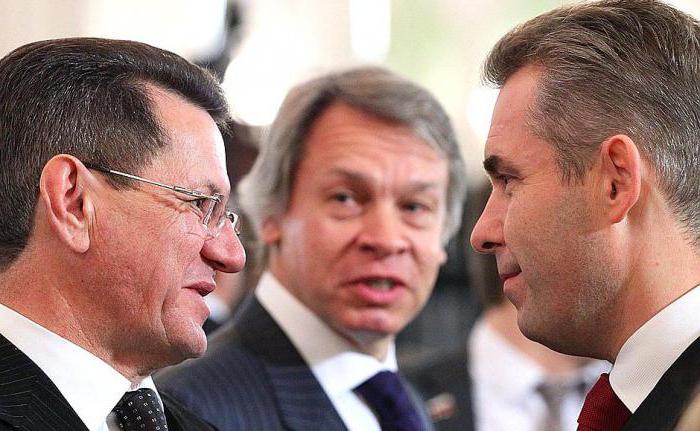The formation of the rule of law is associated with the formation of its basic principles. One of them says about the separation of powers. In Russian reality, the Federal Assembly is the legislative branch, the Russian government is the executive branch, and the judicial is carried out by the Supreme, Constitutional, Supreme Arbitration and other courts of the Russian Federation.
Formation of a representative body in Russia
The existence of parliamentarism in Russia can be observed since the formation of statehood. Under the prince there were deliberative bodies. The Boyar Duma acted first, and later the Zemsky Cathedral. The boards created by Peter the Great, the Senate and the Synod, also served as advisory and representative bodies.
In a classic European form, parliament appeared in the Russian Empire at the beginning of the twentieth century. The 1905 State Duma election manifesto laid the foundations for representation from the state’s population. The elected Supreme Soviet of the USSR, in its own way, continued the initiative it had begun.
In the nineties, the Federal Assembly was formed in its modern form. The year 1993 was the birth of a new authority according to the Constitution adopted on December 12th.
Legislative framework
In the current version of the law of higher legal force, a separate fifth chapter is allocated to the foundations of the activity, formation and structure of the Federal Assembly. It follows the chapter, which presents a description of the powers and activities of the President of the Russian Federation. This indicates the importance of the role and place of the legislature in power structure.
Article 94 of the Constitution of Russia places an equal sign between two concepts: the Federal Assembly is a parliament. It also contains its main characteristics: it is both a legislative and a representative body. In 1994, a constitutional Law on the Federal Assembly was developed and adopted.

Each of the chambers approves its own working order, decides on the issues of its internal routine of activities. The regulation defines the internal structure of the State Duma and the Federation Council, the procedure for meetings, communication of parliamentarians with voters, parliamentary hearings, legislative basis, other issues of activity are being resolved. For the stable operation of both chambers, an apparatus has been created in which public servants work.
Legislative and representative body
Article 94 of the Constitution of the Russian Federation says that the Federal Assembly is an organ of legislative power. This means that all laws of the Russian Federation become so after consideration and approval by their parliament. In a different way, legislative initiative cannot turn into law.
The recognition of the Federal Assembly by the representative body indicates the principle of its formation. Representation of the people is expressed in the conduct of elections. The political will of the country's population gives the elect the right to make any vital decisions for the fate of the entire state.

Only the presence of signs of parliamentarism speaks of the actual basis of the legislative and representative body. It:
- the establishment of a collegial institution;
- the activities of the chosen people are built on an ongoing basis and paid;
- There are legislatively defined forms and methods, powers and tasks of the elected chamber.
Structure of the Federal Assembly
The Federal Assembly of the Russian Federation is a structure of two main elements. Section 95 of the Constitution characterizes the two houses of the Federal Assembly. The upper chamber of the Federation Council is formed of two representatives from subject of the federation. One is sent from the executive branch, the other is recommended by the elective. To date, the Russian Federation has eighty-five entities, respectively, one hundred and seventy people - the total number of members of the Federation Council.

The State Duma performs the functions of the lower house. She has a certain number of places: four hundred and fifty. Its members are elected for five years. Any citizen of Russia from the age of twenty-one years has the right to become a deputy of the State Duma. At the same time, a person does not have the right to be members of both houses. Since the work of the deputy is financed on an ongoing basis, he must abandon other paid activities. The exception is creative work, for example, teaching, scientific. These provisions are enshrined in Articles 95, 96, 97 of the Constitution of Russia.
Functions of the Federation Council
This is a regularly operating body. Its functions include the powers defined in Article 102. The Federation Council:
- Approves changes in the borders of the subjects of Russia.
- Confirms the decrees of the President of Russia on the introduction of a state of emergency or martial law.
- Calls for presidential election.
- Accepts the resignation of the president.
- Decides on the use of Russian troops outside of Russia.
- Appoints the Prosecutor General of the Russian Federation and judges of the Supreme Arbitration Court of the Russian Federation, the Supreme Court of the Russian Federation and the Constitutional Court of the Russian Federation.
- Appoints the chairman of the Accounts Chamber and half of its auditors, accepts their resignation.

The Council of the Federation of the Federal Assembly without fail analyzes the federal laws approved by the State Duma of a certain range of issues described in Article 106:
- Approval of the federal budget, taxes and fees.
- Money issue and financial, customs, credit, currency, regulation.
- Approval and termination of international treaties of Russia.
- Status and protection of the state border.
- Issues of war and peace.
Functions are performed through created committees and commissions. At the request of time, new ones are formed. Now there are sixteen committees, of which: the newly formed committee on local self-government, on financial and legal issues.
Functions of the State Duma
The State Duma elected by the people begins its work on the thirtieth day after the election. The first meeting is led by the oldest deputy. With the beginning of its work, the powers of the Duma of the previous convocation cease. The President of Russia may schedule the first meeting earlier than thirty days.
The functions of the lower house are defined in Article 103:
- Trust or not trust the government of the Russian Federation.
- Agree on the candidacy proposed by the President of the Russian Federation for the post of Prime Minister.
- Adopt annual government performance report.
- To appoint and dismiss the Chairman of the Central Bank of Russia, the Chairman of the Accounts Chamber and half of its auditors, the Commissioner for Human Rights.
- Press charges against the president to remove him from office.
- Announce an amnesty.
Membership in the Federation Council
The Constitution of Russia determines the procedure for the formation of each chamber. Although the Federal Assembly is a representative body, voters cannot influence the formation of its upper house. It consists of a political elite designed to protect the interests of their region.

The Federation Council operates in two sessions: spring from January to July, and autumn from September to December. Meetings are held at least 2 times a month for one or more days, more often if necessary. Each member has a private seat in the boardroom.
State Duma deputy
A majority-proportional system underlies the formation of the State Duma. One second of the total number of deputies is elected in single-mandate constituencies. The candidate with the most votes is considered the winner. This is a sign of a majority system.
The proportional system is the ratio of the vote of the voter to the number of deputy seats in the Duma. The second half of the lower house deputies is formed by political parties that have crossed the seven percent barrier of participation in elections. In proportion to the votes cast, they get a certain number of seats in the State Duma.
Legislative initiative
Section 104 of the Constitution enshrines the right legislative initiative. According to its regulation, the Federal Assembly has the right to propose a new bill. RF, President of Russia, elected bodies of subjects of Russia. The Constitutional Court of the Russian Federation and the Supreme Court of the Russian Federation are entitled to put forward proposals only on issues of their jurisdiction.

Without the conclusion of the Russian government, initiatives on the federal budget cannot be put forward. This applies to questions on the abolition or introduction of taxes, on the issue of state loans, on the transformation of state financial obligations.
Stages of lawmaking
The bill is submitted to the State Duma. Deputies discuss it, develop and accept it. The following five days after the law is approved by the Duma, are given for transmission to the Federation Council for consideration. Fourteen days is the period during which the upper house must issue a verdict “approved - not approved”. If half of the members voted in favor, the adopted law is passed on to the president (five days for transmission, fourteen for signing). If the Federation Council does not approve the law, the draft is sent for revision to the State Duma. If the head of Russia does not sign the law, then the Federal Assembly (both of its chambers) will reconsider its provisions.

The State Duma has the right to adopt a law without the approval of the Federation Council only in one case, if upon repeated consideration two-thirds of the deputies vote for it. In the same way, when the president returns to finalize the law adopted by the Federal Assembly, he passes in the previous version if two-thirds of the total number of its members speak for him. The head of state will be forced to sign and make it public within seven days.
Features of Russian parliamentarism
A special feature of parliamentarism is the presence of a free deputy mandate. A deputy of the Federal Assembly is not connected in his activity with the will of voters. In exercising his authority, he is guided by legal restrictions and his personal ideas. Voters cannot recall a parliamentarian who has not fulfilled his obligations to the electorate. Their influence is limited only by the fact that they can refuse to trust him and not be re-elected for a new term.
In December of each year, a message from the president to the Federal Assembly is heard. This tradition has developed under the 1993 Constitution. For the first time, the president’s message to the Federal Assembly was voiced in February 1994.
The results of 2015 were summed up in the annual address by President Putin. In such cases, the Federal Assembly should convene as a whole in its two chambers. In addition to the main legislative body, there are other higher authorities and guests of various levels.
Today's reality shows the absence of real opposition to the constitutional majority prevailing in the State Duma. All bills initiated by the president or the government are passed through the legislative structures and acquire the force of law.








